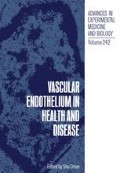Abstract
Clinical and postmortem studies indicate that atherosclerotic lesions on the vessel wall develop not randomly, and not everywhere in the circulation, but at particular localized sites in the arterial tree such as bifurcations, T-junctions, and curved segments of arteries where the blood flow is disturbed and formation of eddies is likely to occur. Thus, to elucidate the possible connection between blood flow and the localized genesis and development of atherosclerosis, a considerable amount of work has been carried out in recent years.1,2 Theoretically, through the development of computational techniques, it has now become possible to simulate the blood flow through various channels, but the analysis is still limited to only those vessels having oversimplified geometries. Experimentally, due to the difficulties in visualizing the detailed flow patterns in vivo, most of the flow studies have been conducted in vitro using various models of arteries3–5 and arterial molds.6–8 However, even with the high quality casting and molding techniques available today, it is still not easy to precisely duplicate the complex geometry of the vessel lumen encountered in various regions of the circulation.
Access this chapter
Tax calculation will be finalised at checkout
Purchases are for personal use only
Preview
Unable to display preview. Download preview PDF.
References
H.L. Goldsmith and T. Karino, Mechanically induced thromboemboli, in “Quantitative Cardio vascular Studies — Clinical and Research Applications of Engineering Principles,” N.H.C. Hwang, D.R. Gross and D.J. Patel, eds., University Park Press, Baltimore, (1978).
G. Schettler, R. Nerem, H. Schmid-Schönbein, H. Mori and C. Diehm, eds., “Fluid Dynamics as a Localizing Factor for Atherosclerosis,” Springer-Verlag, Heidelberg (1983).
B.K. Bharadvaj, R.F. Mabon and D.P. Giddens, Steady flow in a model of the human carotid bifurcation, Part I — flow visualization, J. Biomechanics 15:349 (1982).
T. Fukushima and T. Azuma, The horseshoe vortex: A secondary flow generated in arteries with stenosis, bifurcation and branchings, Biorheology 19:143 (1982).
R. Rayman, R.G. Kratky and M.R. Roach, Steady flow visualization in a rigid canine aortic cast, Biomechanics 18:863 (1985).
S. Moravec and D. Liepsch, Flow visualization in a model of a three-dimensional human artery with Newtonian and non-Newtonian fluids. Part I, Biorheology 20:745 (1983).
O.J. Deters, F.F. Mark, C.B. Bargeron, M.H. Friedman and G.M. Hutchins, Comparison of steadyand pulsatile flow near the ventral and dorsal walls of casts of human aortic bifurcations, ASME J. Biomechanical Engineering 106:79 (1984).
F.J. Walburn, H.N. Sabbah and P.D. Stein, Flow visualization in a mold of an atherosclerotic human abdominal aorta, ASME J. Biomechanical Engineering 103:168 (1981).
T. Karino and M. Motomiya, Flow visualization in isolated transparent natural blood vessels, Biorheology 20:119 (1983).
T. Karino and M. Motomiya, Flow through a venous valve and its implication in thrombus formation. Thrombosis Research 36:245 (1984).
M. Motomiya and T. Karino, Flow patterns in the human carotid artery bifurcation. Stroke 15:50 (1984).
M.R. Roach, The effects of bifurcations and stenoses on arterial disease, in “Cardiovascular Flow Dynamics and Measurements,” N.H.C. Hwang and N.A. Normann, eds.. University Park Press, Baltimore, pp. 489–539 (1977).
M.R. Roach, J.F. Cornhill and J. Fletcher, A quantitative study of the development of sudanophiliclesions in the aorta of rabbits fed a low-cholesterol diet for up to six months, Atherosclerosis 29:259 (1978).
M.R. Roach, and J. Fletcher, Alterations in distribution of sudanophilic lesions in rabbits after cessation of a cholesterol-rich diet, Atherosclerosis 32:1 (1979).
M.R. Roach, S. Scott and G.G. Ferguson, The homodynamic importance of the geometry of bifurcations in the Circle of Willis (glass model studies),Stroke 3:255 (1972).
T. Karino, H.H.M. Kwong and H.L. Goldsmith, Particle flow behavior in models of branching vessels: I, vortices in 90° T-junctions, Biorheology 16:231 (1979).
T. Karino and H.L. Goldsmith, Particle flow behavior in models of branching vessels: II, effects of branching angle and diameter ratio on flow patterns,Biorheology 22:87 (1985).
J.T. Flaherty, J.E. Pierce, V.J. Ferrans, D.J. Patel, W.K. Tucker and D.L. Fry, Endothelial nuclear patterns in the canine arterial tree with particular reference to hemodynamic events, Circ. Res. 30:23 (1972).
C.F. Dewey, S.R. Bussolari, M.A. Gimbrone and P.F. Davies, The dynamic response of vascularendothelial cells to fluid shear stress, J. Biomech. Eng. 103:177 (1981).
M.A. Reidy and D.E. Bowyer, Scanning electron microscopy of arteries. Atherosclerosis 26:181 (1977).
M.J. Levesque, D. Liepsch, S. Moravec and R.M. Nerem, Correlation of endothelial cell shape and wall shear stress in a stenosed dog aorta. Atherosclerosis 6:220 (1986)
Author information
Authors and Affiliations
Editor information
Editors and Affiliations
Rights and permissions
Copyright information
© 1988 Plenum Press, New York
About this chapter
Cite this chapter
Karino, T., Asakura, T., Mabuchi, S. (1988). Role of Hemodynamic Factors in Atherogenesis. In: Chien, S. (eds) Vascular Endothelium in Health and Disease. Advances in Experimental Medicine and Biology, vol 242. Springer, Boston, MA. https://doi.org/10.1007/978-1-4684-8935-4_7
Download citation
DOI: https://doi.org/10.1007/978-1-4684-8935-4_7
Publisher Name: Springer, Boston, MA
Print ISBN: 978-1-4684-8937-8
Online ISBN: 978-1-4684-8935-4
eBook Packages: Springer Book Archive

